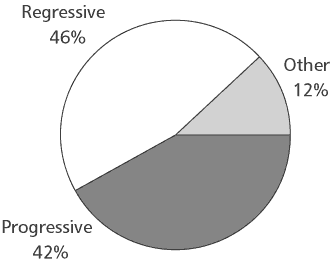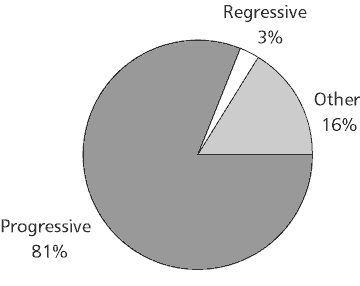The mainstream press tells us that the recession is over. And George W. Bush has proclaimed the economy "strong." But many states are facing their worst budget deficits since the Great Depression. Overall, state governments are contending with total deficits of between $70 and $80 billion for fiscal year 2004 (which begins July 1 for most states), on top of the $26 billion gap that has opened up in fiscal 2003. With such extreme shortfalls, state governments face unappealing options: either cut spending on services such as education and public health, or raise revenue from state fees and taxes.
Unlike the federal government, most states are constitutionally obligated to balance their budgets before voting on the upcoming fiscal year's spending bills. Unfortunately, this budget balancing threatens to worsen the economic slump. Both spending cuts and tax increases remove demand from the economy—directly (through reduction of government expenditures) or indirectly (by reducing consumers' disposable income). Figure 1
Tax Changes, 1990-1993
Percent of Additional Revenue by Type of Tax Increase*

*Forty-six percent of the additional revenues (from tax hikes) came from increases in regressive sales and excise taxes. Figure 2
Tax Changes, 1994-2001
Percent of Tax Reduction by Type of Tax Cut*

* Eighty-one percent of total state tax cuts (in dollars) during this period were reductions in progressive taxes.
Source: "The Rising Regressivity of State Taxes," Center on Budget and Policy Priorities, January 2002.
Business cycles and government budget crises may be facts of life under capitalism, but states' current crises have been exacerbated by the way state lawmakers chose to handle the last business cycle. During the last recession, in the early 1990s, budget shortfalls prompted states to raise taxes. Nearly half of the hikes were on regressive taxes (those more burdensome on lower-income people) such as sales and excise taxes.
During the "bubble economy" boom of the mid-to-late 1990s, state treasuries overflowed with surpluses. State politicians, apparently believing the unprecedented volume of tax revenue would last forever, made permanent cuts in taxes—though not on the same taxes that they had raised during the recession. Instead, the taxes that they cut were overwhelmingly the progressive taxes (those more burdensome to the affluent, such as graduated personal-income and corporate-income taxes). States tended to leave the regressive tax hikes in place. In other words, politicians seized the opportunity afforded by temporary tax windfalls to permanently rewrite the tax code in a more regressive way. (See Figures 1 and 2.)
| Income Group | Poorest 20% | Top 1% | Ratio of Poorest 20% to Top 1% |
| Washington | 17.6% | 3.3% | 5.4 |
| Florida | 14.4% | 3.0% | 4.8 |
| Tennessee | 11.7% | 3.4% | 3.5 |
| South Dakota | 10.0% | 2.3% | 4.4 |
| Texas | 11.4% | 3.5% | 3.3 |
| Illinois | 13.1% | 5.8% | 2.2 |
| Michigan | 13.3% | 6.7% | 2.0 |
| Pennsylvania | 11.4% | 4.8% | 2.4 |
| Nevada | 8.3% | 2.0% | 4.2 |
| Alabama | 10.6% | 4.9% | 2.2 |
States with low (or flat rate) income taxes are often touted by politicians and media pundits as "low-tax" states. Rarely is it noted that these very states tax their poorest citizens heavily. For example, a resident of Washington State in the lowest fifth of income earners pays 17.6% of her yearly income in state taxes, according to the Institute on Taxation and Economic Policy. (See Table 1.) States' adherence to "orthodox" tax policy has hardly kept them out of fiscal crisis. Three of the states among the ten with the most regressive taxes also made the list of those with the biggest deficits as a percentage of planned state spending. (See Table 2.)
State lawmakers' enthusiasm for cutting progressive taxes caught up with them in 2002. With the federal government providing little or no assistance, states made drastic cuts—to health and human services (such as Head Start, vocational training, and Medicaid), and education—cuts that are harmful not only to those directly affected but to the overall economy and society.
| Alaska | 37.8% |
| California | 28.6% |
| New York | 26.7% |
| Oregon | 23.8% |
| Texas | 19.3% |
| Nevada | 19.0% |
| New Jersey | 19.0% |
| Minnesota | 18.7% |
| Wisconsin | 17.6% |
| Michigan | 17.5% |
The states' fiscal problems are perfectly solvable, although a solution would require that the federal government rearrange its priorities. The Bush administration, relentlessly pandering to the nation's wealthiest individuals and corporations, has recently submitted a budget with the largest deficit ever (at nearly $400 billion). This figure does not include the billions of deficit dollars that are being diverted to buoy military contractors' and oil companies' profits—a process euphemistically referred to as "Operation Iraqi Freedom."
As fate would have it, the states' combined FY2003 and FY2004 budget deficit of about $100 billion coincides with low-end estimates of what the war in Iraq will cost. Deficit dollars, rather than be flushed into the "glorious quagmire" of potentially endless war, should be used to save the states from financial ruin.
